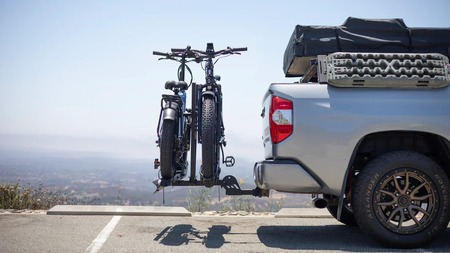
You’re out on a ride, enjoying the wind in your face, when suddenly, your e-bike battery dies. Annoying, right? The demand for rapid, sustainable charging options is increasing, with many users now opting for 2 bike hitch rack for commuting or leisure riding. This is where solar-powered bike racks come in, and honestly, they’re a game changer.
What Are Solar-Powered Bicycle Racks?
Solar bike racks are just what they appear to be: bike racks that use sunlight to charge your e-bike. They resemble ordinary racks, though with a minuscule solar panel on top. This panel collects solar energy during the day, which it stores in a battery or transfers directly to your bike.
While traditional charging stations connect to the grid, these racks run entirely on renewable energy. There is no cable snaking across the sidewalk or hunting for an outlet—just park and plug in. It’s easy, clean, and clever.
Why Do They Matter?
These frames do a lot more than provide a little convenience. Here’s why they’re a huge deal:
Clean Energy: Powered by solar, so emissions = zero, and no strain on the local power grid.
Easy Access: Bike commuters can charge their rides at work, students can juice up during class, and tourists don’t have to worry about battery range.
Long-Term Value: Their setup costs a bit, but not spending on electricity bills or tons in maintenance adds up over time.
Inspires Green Living: As more eco-tech becomes visible, people are inspired to make sustainable choices.
Off-the-grid option: Ideal for regions with little or no access to power.
How Do They Work? (Don’t Worry, It’s Simple)
Here’s a quick overview of how the solar-powered racks work:
The solar panel on top accumulates sunlight during the day.
This energy is stored in a tiny internal battery or used immediately to charge e-bikes, similar to how a deep cycle RV battery stores and delivers long-lasting power for recreational vehicles.
Riders can plug their bikes directly into a charger, often via a standard port.
The more advanced racks might offer additional features, such as USB ports to charge your phone, a display showing how many kilowatts of juice you have available, or even an app that lets you check availability.
You don’t have to be a tech whiz to take one. Park it, plug it in, and you’ll be ready to hit the road.
Who Should Use or Install It?
These ebike rack have potential pretty much wherever people ride e-bikes:
Urban planners can fix them up with the metro stations or downtown roads.
Colleges can provide on-campus charging locations for students and employees.
Office buildings and tech parks can offer sustainability-minded employee’s options that “support their habits.”
Apartment complexes can appeal to renters who have e-bikes.
Shopping malls and tourist places can increase footfall by providing this convenience.
Basically, there’s a reason to install these in the bike traffic.
Examples & Use Cases from the Real World
This is not simply an idea for the future. It’s already happening.
Several cities, including San Francisco and Amsterdam, are experimenting with or have deployed solar-powered e-bike and e-scooter charging stations. Some companies are creating innovative racks that do more than just recharge bikes: They also gather data the number of bikes parked, energy consumption, etc. That information can make urban planning and traffic flow more efficient.
In other words, it’s more than a bike rack it’s a piece of a more innovative, cleaner city.
Cost and Maintenance
Now, let’s talk about money. Solar-powered racks cost between $ a couple hundred and $ a couple thousand dollars,, depending on their features, size, and storage capacity.
The good news is that solar panels are low-maintenance. They have no moving parts and are designed to last, so maintenance is minimal. Over time, they pay for themselves by lowering energy costs and attracting green-minded consumers or renters.
What Are the Challenges?
Of course, no technology is without imperfections. Here are some things to know:
Weather Dependence: Limited sunlight = less effective charging. Performance can be impaired during cloudy days.
High initial investment: Upfront costs for specific businesses or tiny towns can be high.
Security: Outdoor tech is always at risk of theft or vandalism.
Suitable Location: The panels require good sun exposure, so they might not work as well in shady areas.
But with careful design and savvy installation, those challenges are straightforward to address.
Great Gig in the Sky (of Los Angeles)
As more cities develop, solar-powered magazine racks will likely become the norm. App-controlled systems, real-time usage tracking, and modular units that can grow as needed are already part of the development process.
The best part? These racks are not only practical; they communicate something as well. A message that we’re heading toward a cleaner, greener, more sustainable planet.
Final Thoughts
Solar-powered bike racks that charge e-bikes are more than a clever idea. They’re a move forward. For riders, they provide world freedom. They provide sustainability and innovative solutions to cities. And they’re a nice, clean breath of fresh air for the planet.
So, if you’re a city official, a business owner, or really love your e-bike, you may want to prepare for some changes.
No solar-powered racks. Because this isn’t merely about charging batteries. It’s about charging ahead.
